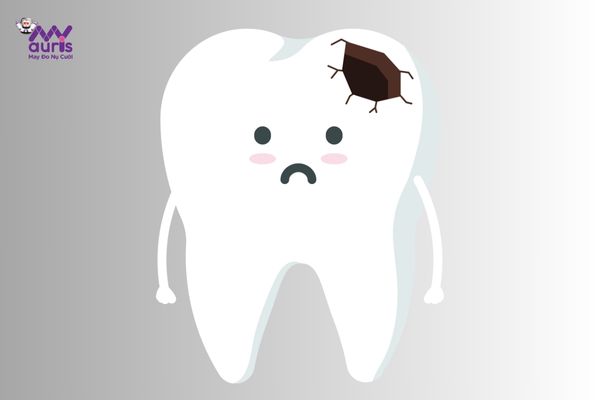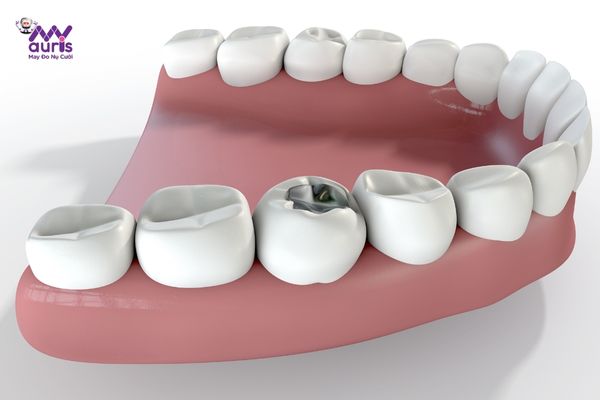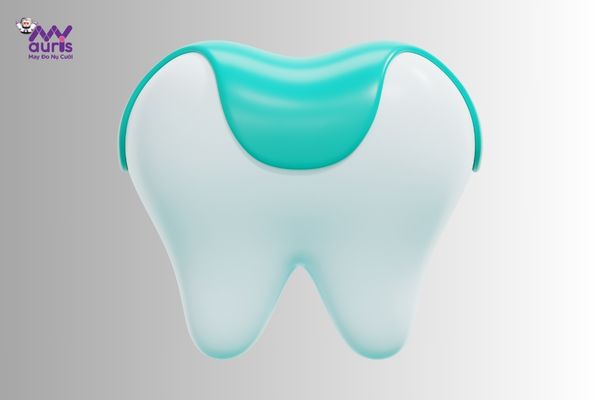Large cavities in teeth cause many impacts, not only losing aesthetics, making communication difficult, but also hindering chewing and causing pain and discomfort. Treating cavities and filling teeth as soon as possible to prevent bacteria from continuing to “raise” will be better for oral health. Sohow much does it cost to fill a cavity, let’s find out with My Auris dentistry through the following article.
Learn about large cavities
Large cavities are a condition that occurs when teeth have been decayed for a long time but there is no intervention or treatment. This causes bacteria to continue to attack and spread, further corroding the tooth structure. From there, at 1 point deep, the hole gradually becomes smaller, forming large holes on the tooth surface.
The most common case of large cavities is in the molars. Because these teeth are located in the jaw, they are difficult to observe and clean. Cavities form inside, so if you don’t feel pain, it’s difficult to see if the tooth has a problem. It is only when the condition becomes severe and symptoms of severe pain begin that it is noticed.

Large cavities not only directly affect aesthetics but also pose many potential health risks:
- Pain affects the nerves so it can cause headaches
- Infection leads to tooth pulp death
- Oral cavity infection
- Teeth become brittle, no longer strong but fragile and easily broken.
Is it possible to fill large cavities in teeth?
To determine whether the cavity is large or small and what treatment method is appropriate, people should visit Examination at a reputable dental facility/hospital. The doctor will examine, check and diagnose the level of tooth decay to provide appropriate treatment.
The doctor will give the customer an X-ray to check the extent of tooth decay. If the decay is mild and has not yet penetrated the tooth pulp, then apply a cosmetic filling method to protect the tooth. The technique of using dental materials to fill cavities to prevent bacteria or food from entering and causing infection. The tooth filling method is quick, at a reasonable cost, and suitable for many people.

However, if the cavity is large, filling is not the optimal solution. Although teeth can still be filled, the durability will not be high because large cavities will require a very large filling area. From there, the adhesion ability of the filling material will be reduced. And when chewing, the filling site will be subjected to frequent impacts over a long period of time, making it susceptible to peeling. Therefore, with large cavities, especially those that have penetrated the tooth pulp, the doctor will perform root canal treatment and then fill the cavity or, if the customer has treatment, will perform porcelain coating to restore the tooth structure.
Some dental materials used in tooth fillings
Even though filling large cavities is not a priority, there are still cases. Customers need to use this method. Therefore, dentistry will still have suitable materials for filling large cavities as follows:
Amalgam
This is a dental filling material made from an alloy of mercury, tin, silver,… Amalgam is a traditional filling material with high strength and longevity. durable. Therefore, with large cavities, Amalgam material’s durability and hardness will ensure better usage time and efficiency.
However, this material has the disadvantage of having a metallic color and is quite different from the color of real teeth. Therefore, in order not to affect aesthetics, Amalgam is usually only suitable for inner molars.
Composite
Composite dental fillings are the most popular and widely used material today. This material is more improved than Amalgam material. With a milky white color similar to the color of real teeth, when filling teeth, it will be aesthetically pleasing and difficult to be detected by the other person.
Besides, composite also has very high compatibility and does not harm teeth or body health. However, with large cavities, composite is only suitable for temporary tooth filling and is not suitable for long-term use. Because the durability of Composite fillings is not highly appreciated, it is easy to be damaged and peel off after just a short time.
Porcelain Inlay- Onlay
Ceramic Inlay/ Onlay fillings are a perfect solution to fix cavities in teeth at the present time. The fillings will be made from high-quality ceramic material so they have good resistance and excellent adhesion.
Different from conventional filling techniques. Porcelain Inlay/onlay will be manufactured separatelyThe laboratory is based on each customer’s actual tooth impression.

How much does it cost to fill a tooth with a large cavity?
How much it costs to fill a cavity depends on many different factors, on the degree of difference in each customer. Because of some of the following dependent factors:
- Number of teeth to be filled
- Is root canal treatment needed?
- Dental facilities
- Dental filling material.

Each dental clinic will have different service prices, so it is difficult to say exactly how much it costs to fill a cavity. body. Normally, this price ranges from 500,000 VND/tooth.
And to determine exactly how much a cavity filling costs, everyone should go to a reputable dentist for an examination and listen to detailed advice.
Steps in the process of filling large cavities
How much it costs to fill large cavities varies at each dental facility, However, in general, the dental filling process has the same basic steps as follows:
- Step 1: The doctor will examine your oral health and see how many cavities there are. Then, have the customer take an X-ray to see whether the cavity is large or small and whether it has eaten into the pulp. From there, a treatment method is proposed before performing dental fillings.
- Step 2: The doctor uses a high-speed drill or hand tool to grind away the decayed tooth enamel.
- Step 3: Apply a green gel with a slightly sour taste to the tooth to clean the tooth again and then rinse.
- Step 4: Blow dry the tooth surface and isolate the tooth that needs to be removed.m to keep the cavity dry, free from saliva contamination and moisture.
- Step 5: Apply glue and place the dental filling material on the tooth to fill the cavity.
- Step 6: Shape the filling into a shape similar to a real tooth
- Step 7: Shine a blue Laser light on the tooth to solidify the material. filling.
- Step 8: Check the bite to see if it is suitable, whether there is any discomfort, and make small adjustments if necessary. Finally, the doctor will grind smooth any rough edges, polish the surface, and complete the filling process.

Hopefully the information in the article about how much it costs to fill large cavities will help people better understand the method and cost. Choose a reputable dental facility that ensures quality standards to perform tooth fillings and cavity treatment. Please contact My Auris Dental immediately for advice and to schedule an examination as soon as possible.
Anh Thy





